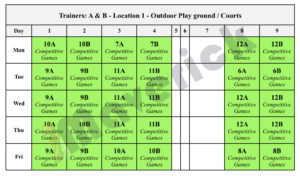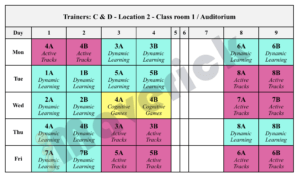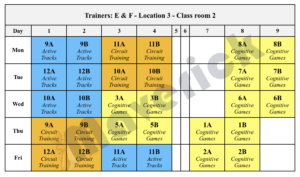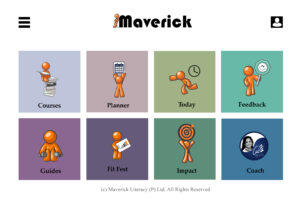HOW WE UNFOLD…
Research shows that children above the age of 6 need 60- minutes of physical activity every day! However, many schools have both space and time constraints to facilitate this. Maverick is designed to help resolve this and facilitate easy implementation across all classes.
Space:
An important resource to consider is availability of space to have every day sessions for all students in the school premises. In this regard, the uniqueness of the Maverick physical literacy curriculum is the ability to conduct most of the sessions in indoor class rooms.
Time:
It is not possible to have the entire school play together before or after school hours due to both space and manpower constraints to monitor the entire school. With the Maverick program being conducted indoors, it becomes feasible to incorporate the session right through the day.
Volume:
In many cases a few students are made to exercise while the rest remain inactive. Maverick sessions are designed to make all students participate for maximum duration while incorporating recommended rest periods.
Here is a set of sample Time Tables to plan…



Many school time tables include only 2 periods of PT every week. Many a time older children don’t even have one PT period due to academic pressure. It becomes imperative to make the Maverick sessions compulsory to ensure impact on both short and long term goals.
FACILITATORS:
The execution of the program is by dedicated Maverick coaches who will be specially trained by Maverick in person before the academic year. The training includes Child safety & Exercise precautions, Principles of Physical Literacy, Preparation of layouts, Science of the proposed activity / fitness sessions, Demonstrations of every exercise, quantitative and qualitative assessments and impact monitoring, Rhythm and Music co-ordination, Safe keeping of materials, Administration & reporting.
In addition to the above, training is also given for the use of technology as the entire delivery of the program is through our custom Maverick trainer app provided in a Tab by us. They will also be using our e-learning online classroom on a daily basis to verify, report and conduct the sessions.
The recommended Trainer:Student ratio is 1:25 for all classes with additional teaching aids for younger classes if necessary.
Trainer knowledge is to facilitate delivery of the program and not design.
Qualifying as a Maverick Fit Kids trainer requires 100 hours of intense training and passing an evaluation consisting of both practical and scientific knowledge on lessons taught, technology used and administrative reporting incorporated for perfect delivery.
Language of instruction is English.
Maverick Coordinators visit schools every term to review and evaluate actual delivery.
Maverick can also provide a basic program for the physical education teachers to conduct on their own. (Contact us for details)
TECHNOLOGY:
At Maverick, we use technology to enhance our creativity by sharing and empowering beyond boundaries; & increase our productivity using automation to magnify our efficiency. All lessons are available to the trainers in the Maverick Tab with Music, Time Tables, checklists, schedules, student details and references. The progress for every session is monitored and very systematic reporting maintained. Elaborate follow up methods ensure the program is delivered correctly.
The lessons include:
- PLANNER with year long Time Table complete with locations & trainers
- TODAY listing the day’s classes & timings
- CHECKLIST for every session with full list of materials required
- Maverick SESSION complete for every lesson with special audio & teaching aids
- COMPLETION REPORT submitted to keep a record of the sessions held.
The tabs work without a need for wifi to deliver the lessons making it possible to conduct sessions even in remote areas. The tabs need to be synchronised with our Amazon cloud and refreshed once every day to update completion reports, feedback and testing results. The tabs are geo-fenced and can be used only in the school it is allotted to.
While the entire curriculum is delivered using the Maverick Trainer app, monitoring delivery of the program is also via the School portal that includes student data, timetables, reports and automated emails to parents on the science of every Maverick session.
Video lessons on hygiene, nutrition, health, fitness and mental wellbeing are conducted every month to promote physical literacy, provide scientific validations and inculcate a sense of enquiry in students.
Qualitative and Quantitative assessments:
Physical Literacy is not a state but an attitude. Fitness is not an end result that can be frozen as an accomplishment in a chart. It is a continuing process that can be achieved only through awareness. While quantitative improvements like how many minutes did you take to complete a particular movement task, or how many squats you did in a given time frame, helps monitor progress in certain ways, qualitative changes in terms of our awareness to our body, our actions to choose healthy options, our accountability to stay fit – these are most crucial for a lifetime committment to be fit!
Fit Fest is a series of assessments on various fitness parameters to record QUANTITATIVE changes in students of classes 1 to 12. Quantitative data provides access to information in a standardised format. These quantitative tests indicate student’s fitness level in relation to peers. These tests are elaborate and are conducted over several weeks, once during an academic year in tune with the NCERT’s policy.
 The process of positive constant change can only happen with the active involvement of the mind! Minds are shaped by thoughts which in turn are a reflection of our attitude. So at Maverick, we constantly strive to keep making QUALITATIVE transformations in student’s approach to staying healthy. With this in mind we present Maverick’s 3A review – Awareness-Advocacy-Action plan for students of classes 1 to 8. We work on particular areas of physical movement to create awareness, advocate their importance and create action plans to improve upon them. The areas we focus on are
The process of positive constant change can only happen with the active involvement of the mind! Minds are shaped by thoughts which in turn are a reflection of our attitude. So at Maverick, we constantly strive to keep making QUALITATIVE transformations in student’s approach to staying healthy. With this in mind we present Maverick’s 3A review – Awareness-Advocacy-Action plan for students of classes 1 to 8. We work on particular areas of physical movement to create awareness, advocate their importance and create action plans to improve upon them. The areas we focus on are
- Motor Coordination – The ability to quickly stop, update and change or switch movement during activity is called motor coordination. This ability to quickly adapt the bodily movements to changing environment enhances mental control of stopping, updating and switching, thereby improving quality of decision making in later years.
- Creative Movement – Creative movements are those that display adaptive usage and encourage application of movements with purpose. It reveals the involvement of the student and the willingness to participate in physical activity.
- Manipulative motor skills – Manipulating an object to move in sync with our own body movement is an acquired skill that improves control. Mastering this helps in greater object control over the years.
- Cognitive reaction time – General alertness and motor speed when moving in response to given stimuli or command refers to cognitive reaction time. Just as how the body predicts and adapts its movement physically, our brain learns to make such predictive and corrective actions for mental tasks too encouraging high level reasoning.
- Contralateral movements – Contralateral Movement involves opposite sides of the body working together to activate both sides of the neo-cortex. Crossing the mid-line during movement indicates that the right and left side of the brain are working together. During contralateral movements the two sides of the brain are forced to communicate, and this strengthens the nerve-cell pathways linking both sides.
- Hand-Eye Coordination – The coordinated control of hand movement with eye movement is an important skill for every sport. It is part of the mechanisms of performing everyday tasks; in its absence most people would be unable to carry out even the simplest of actions such as picking up a book from a table or playing a video game.
- Rhythmicity & Timing – A child’s capacity for rhythmicity and timing helps to build the foundation for his / her emotional and intellectual development. Harmonious, rhythmic movements can be correlated with cognitive capacity. Rhythmicity is an important ability and one that we can enhance through practice and effort.
- Spatial awareness & Sequencing – Spatial awareness is the ability to be aware of oneself in space. It is an organised knowledge of objects in relation to oneself in that given space and involves understanding the relationship of these objects when there is a change of position. Sequencing refers to the order of the components and the ability to reproduce the same sequence. Helping children sequence, develops their scientific inquiry skills.
- Agility – The ability to move quickly and easily while changing directions is called agility. It is crucial for improving speed of movement as it gives confidence and competence.
- Coordination – The harmonious combination and interaction of various body movements is called as coordination. It adds grace to movement and improves physical efficiency.
- Dynamic Balance – When the body balances on a stationery base, it is called static balance. However, when the body balances on a dynamic base like during riding a bicycle or water skiing, it is called a dynamic balance. It is crucial for long term mobility.
- Stamina – Stamina is the ability to sustain prolonged physical / mental effort. It reveals the physical constitution of the individual.
- Pattern Recognition – The process of matching information from a stimulus from outside, with information retrieved from memory is called pattern recognition. Recognising patterns allow us to predict and expect what is coming.
- Physical Functional Capacity – The operational capacity of the body to manage tasks that require physical effort and the goals set for it is called physical functional capacity. Rather than distinguishing it based on the muscles used, it is the combination of muscles for functional movements in a dynamic environment that is monitored.
These reviews are conducted during the course of the year long lessons and term end reports provided to parents.
ACCOUNTABILITY:
We monitor every student with an Accountability review…
Use of the Maverick student portal & app to stay in touch with us by students, helps us monitor their committment to a lifetime of being healthy!
A student app is available for use on parent’s phones for every enrolled student to inculcate exercise habits with an option to connect with friends. Music is provided to students to workout at home with a host of other features like animated exercises, infographics, video insights, quiz etc., to inculcate the habit of exercising every day. Maverick’s student portal and smart phone app is a unique platform to Engage, Educate & Empower students to be active for life!
The Android and iOS versions of the app can be downloaded by registered students from Play store & iStore using links provided at the bottom of this page.
IMPLEMENTS:
Maverick uses a lot of innovative child friendly implements to keep the aspect of novelty alive in children.
We use implements to teach movement patterns, equipments to assist in biometric movements, objects for fun and joy (like a boxing bag or balloons) and innovative customised tools to aid cognitive activities. The materials/equipment to conduct the session will be provided for the year by Maverick optimised for a maximum of 40 students in a session at any given time.


